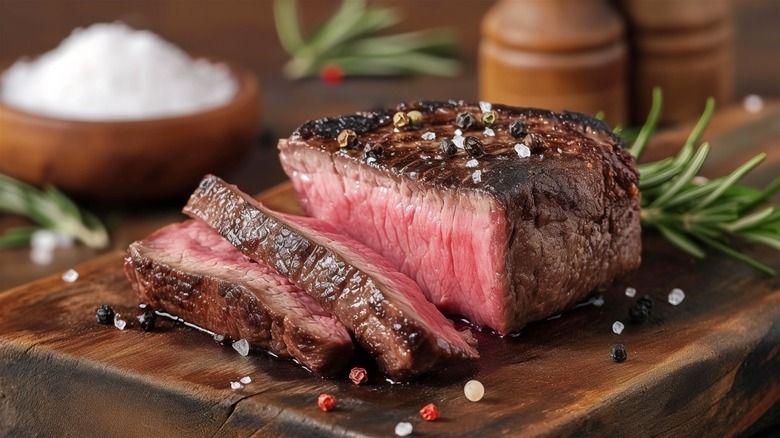Butter Vs Olive Oil: Which Leads To A Better Steak?
When you are ready to make a restaurant-worthy steak at home, it might seem like the difference between using olive oil or butter to sear it would be negligible. Yet, these ingredients can have a massive impact on the meat. According to chef Zoilan Ruiz of Le Rêve Restaurant & Raw Bar, there is a clear winner that leaves you with a gorgeous, tasty sear every time. "For searing steak, clarified butter is an excellent choice," he said. "It has a high smoke point and imparts a rich, nutty flavor that enhances the crust without burning."
Unlike a regular stick of butter that has a low smoke point of 300 degrees Fahrenheit, clarified butter can be heated to 450 degrees before it starts to burn — perfect for getting a beautiful sear. As an example of why you shouldn't always use extra-virgin olive oil in your cooking, Ruiz said, "Avoid using a straight extra virgin olive oil or vegetable oil blend for searing, as both can lead to bitterness or off-flavors." Those bitter flavors occur when the oil is heated past its smoke point of roughly 375 degrees.
Clarified butter works for more than just searing steak, too. When asked whether other proteins might benefit from being cooked with clarified butter, Ruiz said, "Absolutely — most seafood benefits beautifully from being cooked in butter, especially clarified butter. It has a high smoke point, allowing for proper searing without burning, while delivering rich, nutty flavor and a golden, appetizing finish."
Butter should be used for more than just searing
While it may not be one of the biggest mistakes you can make when cooking steak, not accompanying the meat with a flavorful sauce is a missed opportunity to elevate the dish. Including butter in that appetizing sauce gives it a velvety texture and richness that few other ingredients can impart. As for how to actually do that, after you have a perfectly cooked steak resting off to the side of your pan, Ruiz said, "Deglaze the pan with a splash of red wine to lift the caramelized bits, then add minced shallots and fresh thyme, letting them soften and infuse the sauce." Don't worry, the butter is coming.
Then, Ruiz continued, "Stir in a touch of Dijon mustard for tang and backbone. Once off the heat, monter au beurre — whisk in small, cold cubes of butter to create a silky, emulsified finish." For those not in the know, monter au beurre is a French culinary phrase meaning "mount with butter," most commonly used in reference to finishing a sauce. Once the butter is incorporated, all that's left is to give the sauce a chef's kiss. Ruiz said, "Cracked black pepper rounds everything out with bold, aromatic warmth."

